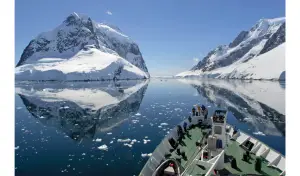At a first glance, the snow-covered poles that sit at the top and bottom of our planet might seem quite similar. However, there are many differences between the Arctic and Antarctica, including the climate, animals, vegetation, residents, and what lies beneath the ice and snow.
Keep reading for tons of facts about Antarctica and the Arctic, along with the similarities and differences between Earth’s two polar regions.
- Where are the Arctic and Antarctica?
- Arctic v Antarctica
- Similarities between the Arctic and the Antarctic:
- Differences Between The Arctic and The Antarctic
- 1. Antarctica is much colder than the Arctic
- 2. Antarctica is an ice cap whereas the Arctic is a tundra
- 3. The Arctic and Antarctica are home to very different animals
- 4. There is more diverse vegetation in the Arctic compared to Antarctica
- 5. The Arctic has 4 million permanent residents whereas Antarctica has none
- 6. Antarctica is a continent but the Arctic is not
- 7. Antarctica contains no countries whereas the Arctic does
- 8. Nobody owns Antarctica whereas parts of the Arctic are under the jurisdiction of other countries
- 9. The timing of the seasons are opposite
- Related Questions
Where are the Arctic and Antarctica?
The Arctic – Defining where the Arctic is can be confusing as there as several different methods. However, the most widely accepted definition of the artic is everything above the Arctic circle which is a line of latitude at 66.5° north. This includes parts of Alaska, Canada, Greenland, Russia, and Scandinavia.
Antarctica – There is less interpretation when it comes to defining where Antarctica lies as there is nothing else around it. Antarctica is the large continent that sits over the south pole.
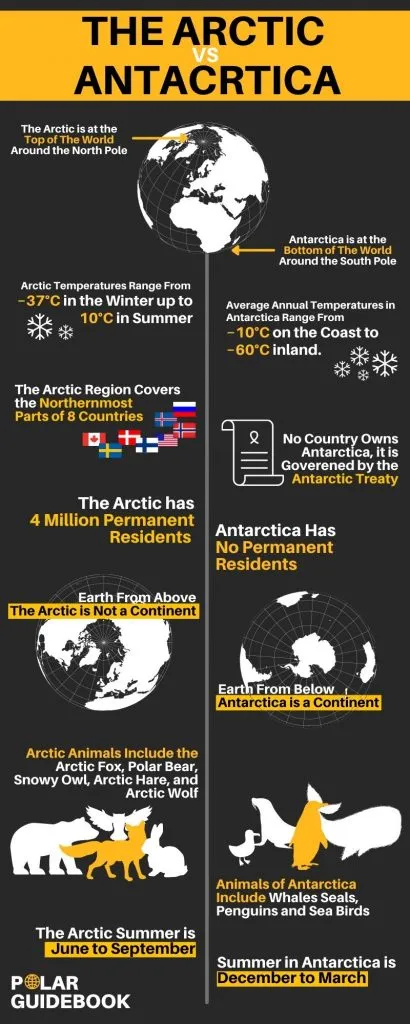
Arctic v Antarctica
Watch the video version here or scroll down to keep reading:
Similarities between the Arctic and the Antarctic:
Let’s begin by taking a look at the similarities between the Arctic and Antarctica:
1. Both Antarctica and parts of the Arctic are deserts
When you picture a desert, the polar regions might not be the first thing to spring to mind, however, both Antarctica and parts of the Arctic are considered to be a desert, albeit a cold one.
The consensus for something to be considered a desert is if it receives less than 250 mm (10 in) of precipitation per year1 (source: Essentials of Geology, 3rd ed, Marshak, 2009), this can be rain, snow, mist, or fog.
Antarctica receives and an average of 150mm of precipitation per year across the continent which makes it a desert. Almost all of Antarctica is a desert with a range from around 50mm per year inland up to 200mm per year near the coast2 (source: Australia Antarctic Program).
Much of the Arctic is also a desert with average precipitation between 150-250m. Some parts of the Arctic Basin and the Canadian Arctic Archipelago are even lower than this.
However, there are also areas with much more precipitation in the Arctic such as Greenland where it can average 400mm or more per year. These areas are not considered a desert.
According to the CIA Factbook, Antarctica and the Arctic are the two largest deserts on Earth:
| Desert | Area |
|---|---|
| Antarctica | 14,200,000 sq km |
| Arctic | 13,900,000 sq km |
| Sahara | 9,200,000 sq km |
| Arabian | 2,330,000 sq km |
| Gobi | 1,295,000 sq km; |
| Kalahari | 900,000 sq km |
| Patagonian | 673,000 sq km |
| Syrian | 500,000 sq km |
| Chihuahuan | 362,000 sq km |
| Kara-Kum | 350,000 sq km |
2. Both the Arctic and Antarctica receive polar nights
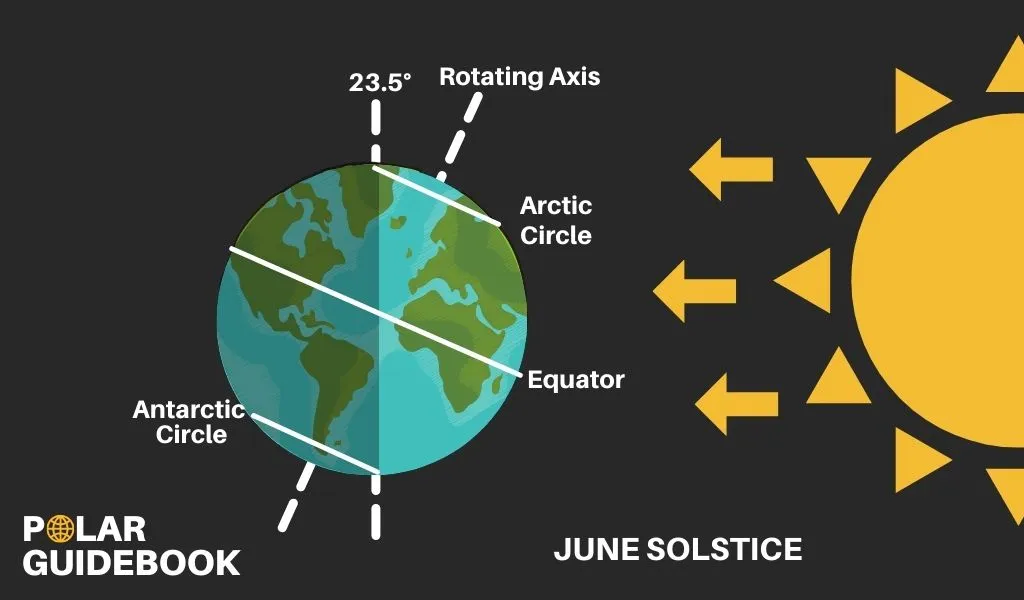
The two polar regions both receive polar nights. This is when the sun is below the horizon for more than 24 hours, resulting in darkness during the day.
This occurs over the winter solstice which is around the 21st December in the Arctic and around 21st June in Antarctica. The image above shows polar nights in Antarctica.
This lasts a few days at The Arctic or Antarctic circle and increases in duration as you move closer to the poles. For example, in the northernmost town of the United States, Utqiaġvik, Alaska, the sun does not rise for around 66 days during the year3 (source: USA Today).
3. Both the Arctic and Antarctica receive midnight sun
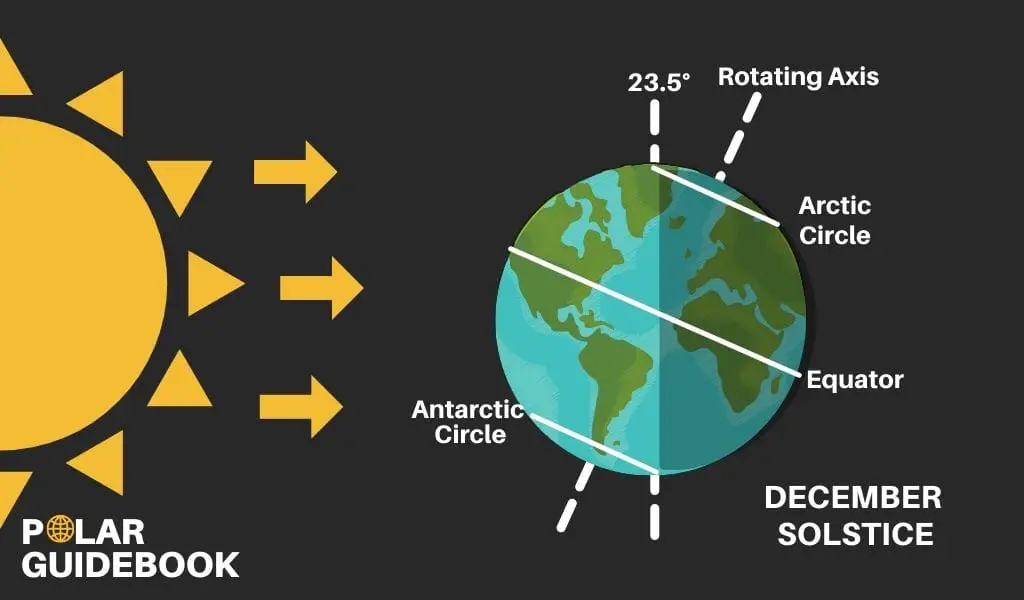
Whilst polar nights occur at the winter solstice, the opposite happens during the summer solstice of the Arctic and Antarctica. This is called midnight sun (also known as a polar day) and is when the sun is above the horizon for 24 hours per day so it is always light.
The summer solstice dates are the opposite of the winter solstice, occurring around the 21st of June in the Arctic and around 21st December in Antarctica. The image above shows midnight sun in Antarctica.
Similar to polar nights, the duration of the midnight sun increases as you get closer to the poles.
Svalbard is a group of islands situated about halfway between Norway and the North Pole. It is one of the world’s northernmost inhabited areas. Here, the midnight sun lasts for 124 days per year4 (source: Visit Norway).
At the poles themselves, the sun only rises once per year, it then stays in the sky for 6 months before setting once per year and does not rise again for 6 months.
Differences Between The Arctic and The Antarctic
Now, let’s take a look at the differences between the Arctic and the Antarctic:
1. Antarctica is much colder than the Arctic
Temperatures in the Arctic vary significantly across the region and between seasons. Typically, temperatures will vary from as low as −35 °F (−37 °C) in the winter up to 10 °C (50 °F) in summer.
As the temperatures are above freezing in summer, it allows the snow to melt and lets vegetation grow.
Meanwhile, Antarctica is colder than the Arctic and is the coldest continent on Earth.
Average annual temperatures here range from around −10 °C on the coast to −60 °C inland. In the most extreme parts of the continent, temperatures can drop below -80°C in Winter5 (source: Australia Antarctic Program).
2. Antarctica is an ice cap whereas the Arctic is a tundra
Although both the Arctic and Antarctica can both be called deserts due to the rainfall, an alternative way of classifying climates is the Köppen climate system. This considers both rainfall and temperatures.
Under this system, the Arctic and the Antarctic fall under different types of polar climates with one being an ice cap and the other being a tundra6 (source: Wikipedia).
Antarctica is mostly an ice cap because monthly average temperatures don’t exceed 0°C (32°F) whereas the Arctic is mostly tundra because the warmest month has an average temperature between 0-10°C (32-50°F).
The main difference between the two is that snow will melt from a tundra during the summer months, allowing vegetation to grow whereas an ice cap will remain snow-covered year-round.
That being said, some of the Antarctic peninsular which is the northernmost part of the continent do exceed 0°C in the summer months7 (source: British Antarctic Survey) and therefore can be classified as a tundra. This is the only part of Antarctica where you’ll find vegetation during summer.
3. The Arctic and Antarctica are home to very different animals
Despite a common myth that polar bears eat penguins, they live at opposite ends of the world. The Arctic has a thriving animal population including the Arctic fox, polar bear, snowy owl, Arctic hare, Arctic wolf, caribou (reindeer), moose, and more.
However, at the southern tip of the planet, there’s quite a different story as Antarctica doesn’t have any naturally occurring land mammals, reptiles, or amphibians8 (source: British Antarctic Survey).
You will find some invertebrates such as earthworms, mollusks, and a few insects, however, it’s best known for its marine mammals, such as whales and seals, and birds including penguins and albatross.
4. There is more diverse vegetation in the Arctic compared to Antarctica
Both the Arctic and Antarctica are home to lower plant species such as mosses, liverworts, lichens, and fungi. These have adapted well to surviving in extreme climates.
However, the big difference between the two is when we look at vascular plants (i.e. flowering plants). In Antarctica, there are only two species of vascular plants, these are Antarctic hair grass and Antarctic pearlwort.
Meanwhile, the Arctic is home to more than 2,200 different species of vascular plants9 (source: Conservation of Arctic Flora and Fauna (CAFF), Arctic Council). This is due to the warmer climate in the Arctic which allows a few inches of soil to thaw each year for vegetation, this is known as the active soil.
5. The Arctic has 4 million permanent residents whereas Antarctica has none
The climate found in the Arctic might be extreme, but people have still found ways to live there for over 20,000 years. It is currently estimated that 4 million people are living in the Arctic which includes indigenous people as well as modern towns and cities10 (source: National Snow & Ice Data Center).
Some of the indigenous communities include Inuits in Canada and the Yup’ik in Alaska, they make up around 10% of the Arctic’s permanent residents although this varies by region from more than 60% in Greenland to less than 1% in parts of Russia11 (source: Arctic Human Development Report, J. N. Larsen and G. Fondahl, 2014).
The rest reside in modern towns and cities with the largest ones including Murmansk (Russia), Norilsk (Russia), and Tromsø (Norway).
By contrast, the sub-zero climate means that Antarctica has no native human population. There are around 1,100-5,000 people from across the world who live at the research centers in Antarctica, although they are usually stationed there for one year before returning home12 (source: Wikipedia).
6. Antarctica is a continent but the Arctic is not
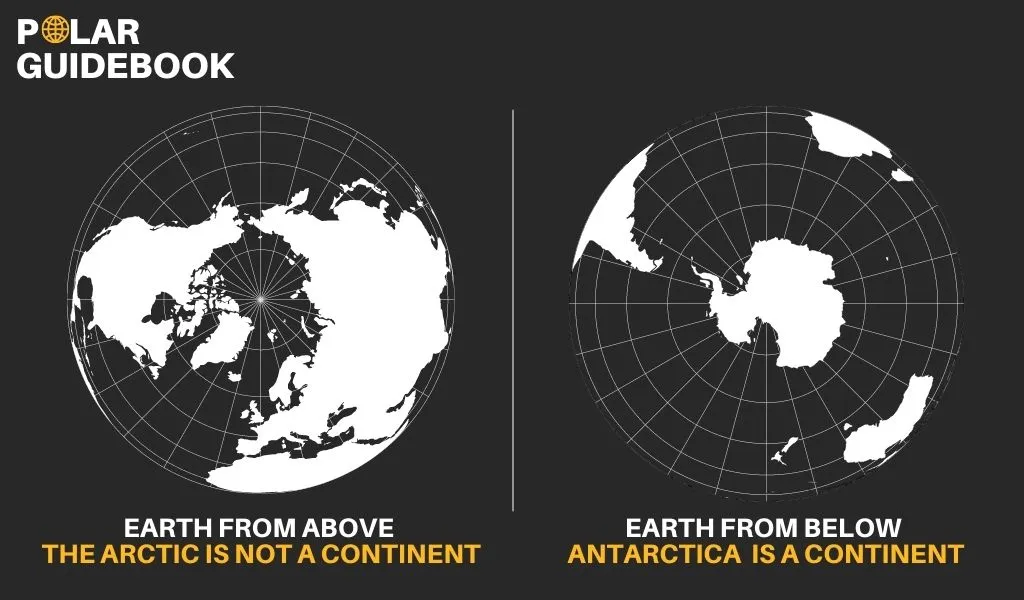
Although Antarctica and the Arctic appear as snowy landscapes. Underneath all the snow you’ll find very different things.
Antarctica is a landmass that was once connected to India and Africa13 (source: Live Science). Over time it has drifted south and froze over. However, underneath it still contains mountain ranges, gorges, and valleys14 (source: British Antarctic Survey).
It sits on the Antarctic tectonic plate, is vast in size, and is distinct from other landmasses on Earth, these are all the criteria needed to consider Antarctica as a continent. In fact, Antarctica is the 5th largest continent on Earth, larger than Europe and Australia.
On the other hand, most of the Arctic is simply sea ice that sits on the ocean so it is not considered to be a continent. Parts of several other countries do fall within the Arctic as they protrude north of the Arctic circle which leads to the next difference between the two.
7. Antarctica contains no countries whereas the Arctic does
Although several countries made territorial claims in Antarctica between 1840 and 1940, all of those countries agreed to set aside these claims when the Antarctic Treaty was formed in 1961 so there are no official countries in Antarctica15 (source: British Antarctic Survey).
On the other hand, the Arctic region covers the northernmost parts of 8 countries, these are Canada, Denmark (Greenland), Iceland, Norway, Sweden, Finland, Russia, and the United States.
8. Nobody owns Antarctica whereas parts of the Arctic are under the jurisdiction of other countries
The entire continent of Antarctica is entirely free of any ownership.
Although seven states made territorial claims in Antarctica between 1840 and 1940, the introduction of The Antarctic Treaty on 23 June 1961 set aside these claims. The treaty has now been agreed upon by 54 countries16 (source: US State Department, Accessed July 2021).
On the other hand, all of the landmasses found in the Arctic, and up to 12 nautical miles (22 km; 14 mi) from the coastline into the sea, is owned by 8 different states. These are Canada, Denmark, Finland, Iceland, Norway, Russia, Sweden, and the USA.
Beyond 12 nautical miles from the coast is considered international waters and is not owned by anybody. The north pole itself sits on sea ice which lies more than 12 nautical miles from a coastline, therefore nobody owns this.
9. The timing of the seasons are opposite
Although both the Arctic and Antarctica have a similar pattern in terms of their seasons, they are completely reversed. In the Arctic, summer is from June to September and winter is from December to March.
Conversely, summer is December to March in Antarctica and winter is June to September. This is because of the tilt of the Earth.
The timing of polar days and midnight sun is also reversed at the south pole compared to the north pole.
There are only two days per year when the amount of daylight is equal at the north pole and south pole, this is the vernal equinox and the autumnal equinox which take place in March and September.
Related Questions
Is the Arctic in Antarctica?
No, the Arctic and Antarctica are at opposite ends of the planet. The Arctic is the area around the north pole whereas Antarctica is at the south pole.
Which is Colder, Antarctica or the Arctic?
Antarctica is colder than the Arctic. Average temperatures in Antarctica are around -60°C in winter compared to -40°C in the Arctic. During summer, most of Antarctica remains below freezing whereas most of the Arctic will peak above 0°C.
What is Antarctica Like vs Alaska?
Although both Antarctica and Alaska are snow-covered landscapes in winter. The main difference between the two is that Alaska thaws out in the summer which allows vegetation to grow and creates a climate that people can live in.
On the other hand, Antarctica remains below freezing year-round so nobody lives there apart from scientists and operational staff such as chefs on a short-term basis.
Is Antarctica at the North or South Pole?
Antarctica can be found in the southernmost part of the world in the area around the south pole.


![You are currently viewing Arctic vs Antarctica [12 Key Similarities and Differences]](https://polarguidebook.com/wp-content/uploads/2021/07/Arctic-vs-Antarctica.jpg)
![Read more about the article How to Get a Job in Antarctica in 2024 [According to People Working There]](https://polarguidebook.com/wp-content/uploads/2023/08/Untitled-design-23-300x176.png)
